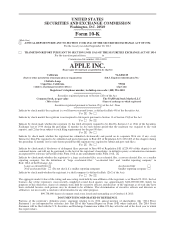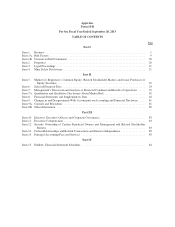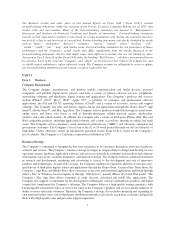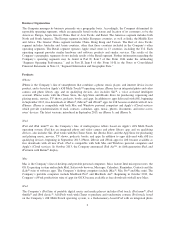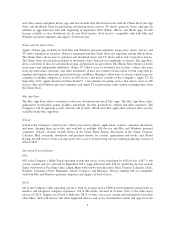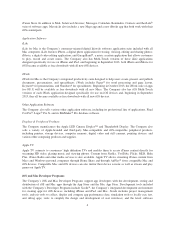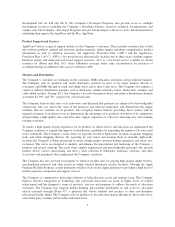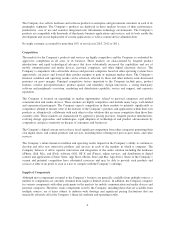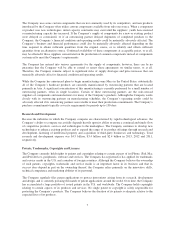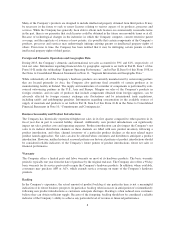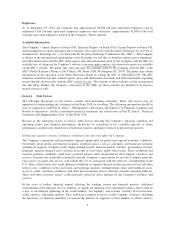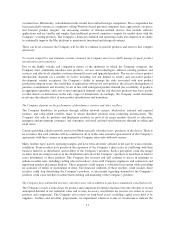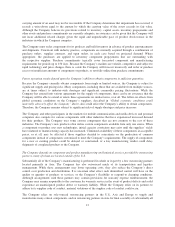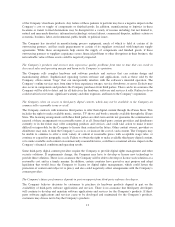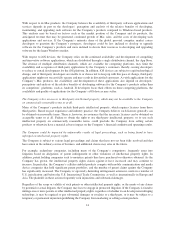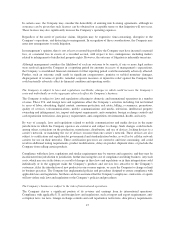Apple 2013 Annual Report Download - page 9
Download and view the complete annual report
Please find page 9 of the 2013 Apple annual report below. You can navigate through the pages in the report by either clicking on the pages listed below, or by using the keyword search tool below to find specific information within the annual report.The Company uses some custom components that are not commonly used by its competitors, and new products
introduced by the Company often utilize custom components available from only one source. When a component
or product uses new technologies, initial capacity constraints may exist until the suppliers’ yields have matured
or manufacturing capacity has increased. If the Company’s supply of components for a new or existing product
were delayed or constrained, or if an outsourcing partner delayed shipments of completed products to the
Company, the Company’s financial condition and operating results could be materially adversely affected. The
Company’s business and financial performance could also be materially adversely affected depending on the
time required to obtain sufficient quantities from the original source, or to identify and obtain sufficient
quantities from an alternative source. Continued availability of these components at acceptable prices, or at all,
may be affected if those suppliers concentrated on the production of common components instead of components
customized to meet the Company’s requirements.
The Company has entered into various agreements for the supply of components; however, there can be no
guarantee that the Company will be able to extend or renew these agreements on similar terms, or at all.
Therefore, the Company remains subject to significant risks of supply shortages and price increases that can
materially adversely affect its financial condition and operating results.
While the Company has announced plans to begin manufacturing some Macs in the United States, substantially
all of the Company’s hardware products are currently manufactured by outsourcing partners that are located
primarily in Asia. A significant concentration of this manufacturing is currently performed by a small number of
outsourcing partners, often in single locations. Certain of these outsourcing partners are the sole-sourced
suppliers of components and manufacturers for many of the Company’s products. Although the Company works
closely with its outsourcing partners on manufacturing schedules, the Company’s operating results could be
adversely affected if its outsourcing partners were unable to meet their production commitments. The Company’s
purchase commitments typically cover its requirements for periods up to 150 days.
Research and Development
Because the industries in which the Company competes are characterized by rapid technological advances, the
Company’s ability to compete successfully depends heavily upon its ability to ensure a continual and timely flow
of competitive products, services and technologies to the marketplace. The Company continues to develop new
technologies to enhance existing products and to expand the range of its product offerings through research and
development, licensing of intellectual property and acquisition of third-party businesses and technology. Total
research and development expense was $4.5 billion, $3.4 billion and $2.4 billion in 2013, 2012 and 2011,
respectively.
Patents, Trademarks, Copyrights and Licenses
The Company currently holds rights to patents and copyrights relating to certain aspects of its iPhone, iPad, Mac
and iPod devices, peripherals, software and services. The Company has registered or has applied for trademarks
and service marks in the U.S. and a number of foreign countries. Although the Company believes the ownership
of such patents, copyrights, trademarks and service marks is an important factor in its business and that its
success does depend in part on the ownership thereof, the Company relies primarily on the innovative skills,
technical competence and marketing abilities of its personnel.
The Company regularly files patent applications to protect innovations arising from its research, development
and design, and is currently pursuing thousands of patent applications around the world. Over time, the Company
has accumulated a large portfolio of issued patents in the U.S. and worldwide. The Company holds copyrights
relating to certain aspects of its products and services. No single patent or copyright is solely responsible for
protecting the Company’s products. The Company believes the duration of its patents is adequate relative to the
expected lives of its products.
7

